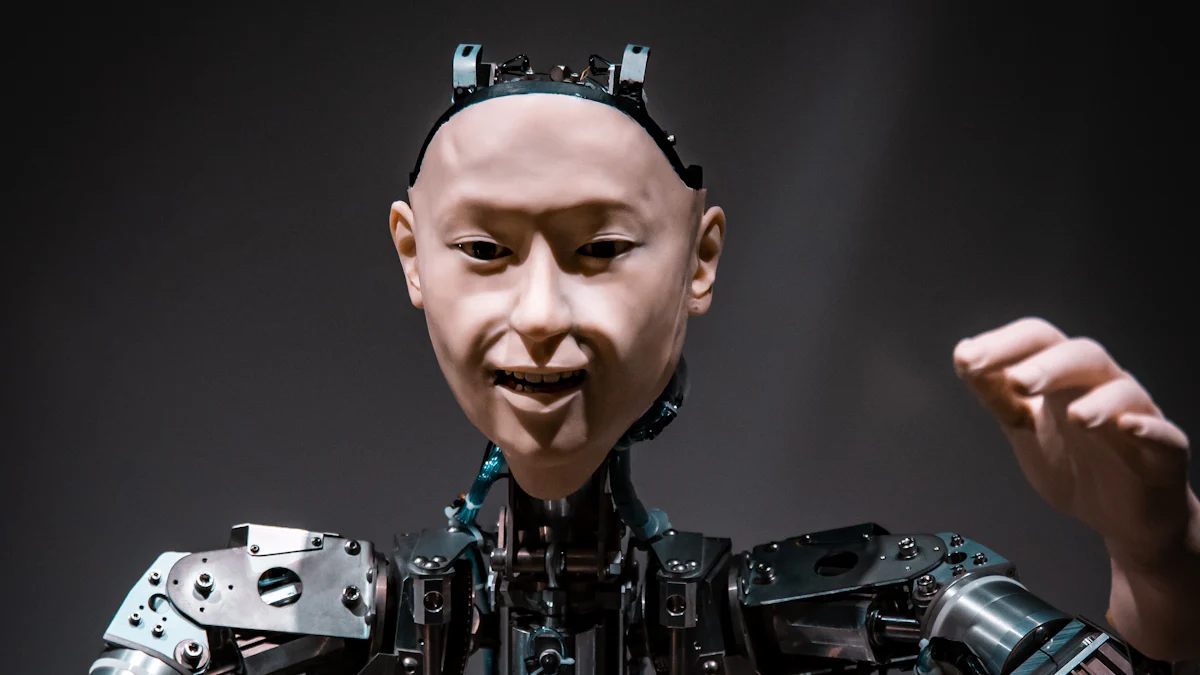How Does Generative AI Differ from Traditional AI?

Artificial Intelligence (AI) has come a long way since its inception. You might have noticed how AI is transforming industries and everyday life. It's not just about robots or automated systems anymore. AI now plays a crucial role in scientific discovery, economic growth, and even tackling societal challenges like climate change. Understanding the different types of AI, such as Generative AI, is essential. This knowledge helps you grasp how AI can create new content and solve complex problems. With 34% of companies already using AI and 42% exploring it, the impact of AI continues to grow.
Understanding Artificial Intelligence
Definition of AI
Artificial Intelligence, or AI, is a fascinating field that has been evolving for decades. At its core, AI refers to machines or systems that mimic human intelligence. These systems can perform tasks like learning, reasoning, and problem-solving. You might have encountered AI in various forms, from virtual assistants like Siri and Alexa to more complex systems used in industries.
Historical context of AI development
AI's journey began in the mid-20th century. In 1956, the term "artificial intelligence" was coined at the Dartmouth Conference. This event marked the beginning of AI as a field of study. Over the years, AI has seen several waves of enthusiasm and setbacks. The 1980s witnessed the rise of expert systems, which were among the first successful AI applications. Fast forward to today, AI is accelerating scientific discovery and even addressing societal challenges like climate change and deadly diseases.
Key components of AI
AI systems rely on several key components to function effectively:
Data: AI needs vast amounts of data to learn and make decisions.
Algorithms: These are the rules or instructions that guide AI in processing data.
Computing Power: Advanced hardware enables AI to process data quickly and efficiently.
Understanding these components helps you appreciate how AI systems work and their potential impact on various fields.
Types of AI
AI comes in different flavors, each with its own capabilities and limitations. Let's dive into the main types of AI.
Narrow AI vs. General AI
Narrow AI, also known as weak AI, is designed to perform specific tasks. It's what you encounter most often in your daily life. For example, a recommendation system on Netflix or a spam filter in your email. These systems excel at their designated tasks but can't do anything outside their programmed scope.
On the other hand, General AI, or strong AI, aims to perform any intellectual task that a human can do. This type of AI remains largely theoretical and is the subject of ongoing research. Imagine a machine that can think, learn, and adapt like a human. That's the goal of General AI.
Role of Machine Learning in AI
Machine Learning (ML) plays a crucial role in the development of AI. It's a subset of AI that focuses on enabling machines to learn from data. Instead of being explicitly programmed, ML algorithms identify patterns and make decisions based on data. This approach has led to significant advancements in AI capabilities.
For instance, Microsoft has been creating AI tools to assist people with disabilities. These tools leverage ML to address challenges faced by individuals with visual, hearing, or cognitive impairments. By understanding the role of ML, you can see how AI is transforming lives and industries.
What is Generative AI?

Generative AI is a fascinating branch of artificial intelligence that focuses on creating new content. Unlike traditional AI, which analyzes existing data, Generative AI can produce original outputs like text, images, and even music. This capability opens up a world of possibilities for creativity and innovation.
Definition and Characteristics
Generative AI refers to systems that can generate new data based on patterns learned from existing datasets. These systems don't just replicate what they learn; they create something entirely new. You might wonder how this is possible. Let's break it down.
How Generative AI works
Generative AI models learn from vast amounts of data. They identify patterns and structures within this data, allowing them to generate new content that resembles the original. For instance, a Generative AI model trained on thousands of images can create a new image that looks like it belongs in the same collection. This process involves complex algorithms and neural networks that mimic the way the human brain processes information.
Examples of Generative AI models
Several Generative AI models have gained popularity for their impressive capabilities. ChatGPT is one such model that can generate human-like text, making it useful for chatbots and content creation. Another example is DALL-E, which can create unique images from textual descriptions. These models showcase the potential of Generative AI to revolutionize content creation across various media.
Applications of Generative AI
Generative AI has found applications in numerous fields, transforming industries and enhancing creativity. Let's explore some of these applications.
In creative industries
Generative AI is making waves in creative industries like art, music, and film. Artists use these AI models to generate new ideas and push the boundaries of creativity. For example, musicians can collaborate with AI to compose original pieces, while filmmakers use AI-generated visuals to enhance storytelling. The possibilities are endless, and Generative AI is becoming an invaluable tool for artists worldwide.
In data augmentation
Data augmentation is another area where Generative AI shines. By generating synthetic data, AI models can enhance existing datasets, improving the performance of machine learning algorithms. This process is particularly useful in fields like healthcare, where obtaining large amounts of real-world data can be challenging. Generative AI helps fill these gaps, enabling more accurate predictions and better decision-making.
Generative AI is not just a technological advancement; it's a creative revolution. As you explore its potential, you'll discover how it can transform industries and unlock new possibilities for innovation.
What is Traditional AI?
Definition and Characteristics
Traditional AI refers to systems designed to perform specific tasks based on predefined rules and algorithms. These systems excel in analyzing data and executing tasks within a limited scope. Unlike Generative AI, Traditional AI doesn't create new content. Instead, it focuses on processing existing information to provide valuable insights or solutions.
How Traditional AI works
Traditional AI operates by following a set of programmed instructions. These systems rely on algorithms to process data and make decisions. For example, Automatic Speech Recognition Technologies (ASR) convert spoken language into text by recognizing patterns in audio input. ASR systems follow specific rules to deliver accurate transcriptions but don't generate new speech or language.
Examples of Traditional AI systems
You'll find Traditional AI in various applications across different industries. Microsoft AI Tools for Disabled People are a great example. These tools assist individuals with visual, hearing, or cognitive disabilities by providing tailored solutions to their unique challenges. Another example is Amazon's AI Algorithms for Predictive Inventory Management. These algorithms analyze market trends and buying patterns to predict product demand, helping businesses optimize their inventory.
Applications of Traditional AI
Traditional AI has become an integral part of many industries, offering solutions that enhance efficiency and decision-making.
In automation
Automation is one of the most common applications of Traditional AI. Businesses use AI systems to automate repetitive tasks, reducing the need for human intervention. For instance, AI-powered chatbots handle customer inquiries, providing quick and accurate responses. This automation not only saves time but also improves customer satisfaction.
In decision-making processes
Traditional AI plays a crucial role in decision-making processes. By analyzing large datasets, AI systems can identify patterns and trends that inform strategic decisions. In finance, AI models assess risk and predict market fluctuations, enabling investors to make informed choices. Similarly, healthcare providers use AI to analyze patient data, leading to better diagnosis and treatment plans.
Traditional AI continues to evolve, offering valuable solutions across various sectors. As you explore its applications, you'll see how these systems enhance productivity and drive innovation.
Key Differences Between Generative AI and Traditional AI

Understanding the differences between Generative AI and Traditional AI can help you appreciate their unique capabilities. Let's explore how these two types of AI differ in terms of functionality and use cases.
Functional Differences
Learning processes
Generative AI and Traditional AI have distinct learning processes. Traditional AI relies on supervised learning, where it learns from labeled data to perform specific tasks. You can think of it as following a recipe with clear instructions. It excels at recognizing patterns and solving predefined problems. For example, a spam filter in your email uses Traditional AI to identify unwanted messages based on known patterns.
On the other hand, Generative AI uses unsupervised learning and generative models. It doesn't need labeled data to learn. Instead, it identifies patterns within large datasets and creates new content. Imagine it as an artist who learns by observing various artworks and then creates something entirely new. This ability to generate novel outputs makes Generative AI a powerful tool for creativity and innovation.
Output generation
The way these AI systems generate output also sets them apart. Traditional AI focuses on analyzing existing data to provide insights or solutions. It doesn't create new content but rather processes information to achieve specific goals. For instance, a recommendation system on Netflix analyzes your viewing history to suggest movies you might like.
In contrast, Generative AI excels at creating new content. It can produce text, images, music, and more, based on the patterns it has learned. This capability allows it to generate human-like text or create unique images from textual descriptions. Generative AI's output generation is akin to a writer crafting a story or a musician composing a new piece.
Use Case Differences
Industry-specific applications
Generative AI and Traditional AI find applications in different industries, each leveraging their strengths. Traditional AI is widely used in sectors like finance, healthcare, and manufacturing. It automates repetitive tasks, enhances decision-making, and improves efficiency. For example, AI models in finance assess risk and predict market trends, helping investors make informed decisions.
Generative AI, however, shines in creative industries. Artists, musicians, and filmmakers use it to push the boundaries of creativity. It generates new ideas, compositions, and visuals, transforming the way art is created. Additionally, Generative AI plays a crucial role in data augmentation, enhancing datasets for machine learning models in fields like healthcare.
Limitations and strengths
Both Generative AI and Traditional AI have their limitations and strengths. Traditional AI excels in domains with well-defined rules and specific expertise. It provides reliable solutions for tasks with clear objectives. However, it lacks the ability to create new content or adapt to unfamiliar situations.
Generative AI, on the other hand, offers creativity and adaptability. It generates novel outputs across various media forms, making it a valuable tool for innovation. Yet, it may struggle with tasks that require precise accuracy or adherence to strict guidelines.
Technological Implications
Impact on Innovation
Artificial Intelligence (AI) is reshaping the landscape of innovation. You see its influence in various fields, from healthcare to entertainment. Let's explore how AI drives advancements and shapes technology development.
Advancements in AI research
AI accelerates scientific discovery. Researchers use AI to analyze vast datasets, uncovering patterns and insights that were previously hidden. This capability speeds up research processes, leading to breakthroughs in areas like climate change and disease treatment. AI doesn't just assist scientists; it transforms how they work, making research more efficient and impactful.
Influence on technology development
AI's influence extends beyond research. It plays a pivotal role in technology development. Companies leverage AI to create smarter products and services. For instance, AI enhances gaming experiences by creating more realistic environments and adaptive gameplay. In healthcare, AI-powered tools improve diagnostics and patient care. As AI continues to evolve, you can expect even more innovative applications that enhance everyday life.
Ethical Considerations
With great power comes great responsibility. As AI technology advances, ethical considerations become increasingly important. Let's delve into some key ethical issues surrounding AI.
Bias and fairness
AI systems can inadvertently perpetuate bias. If the data used to train AI models contains biases, the AI may produce biased outcomes. This issue raises concerns about fairness and equality. You must ensure that AI systems are designed and trained with diverse and representative data. By doing so, you can minimize bias and promote fairness in AI applications.
Privacy concerns
Privacy is another critical concern in the AI landscape. AI systems often require access to large amounts of personal data. This necessity raises questions about data security and user privacy. You need to consider how AI systems handle and protect sensitive information. Implementing robust privacy measures and transparent data practices can help address these concerns and build trust in AI technologies.
AI's technological implications are vast and varied. While it drives innovation and enhances technology, it also presents ethical challenges that require careful consideration. By understanding these implications, you can navigate the evolving AI landscape with awareness and responsibility.
Future of AI: Generative vs. Traditional
Trends in AI development
AI continues to evolve at a rapid pace, and you can expect exciting trends in its development. Let's explore some emerging technologies and potential future applications.
Emerging technologies
AI is constantly pushing the boundaries of what's possible. New technologies are emerging that promise to revolutionize various fields. For instance, Deep 6 AI is transforming healthcare clinical trials by efficiently locating potential trial participants. This innovation speeds up the research process and enhances the accuracy of clinical trials. You might also see advancements in AI-powered tools that assist in personalized entertainment, offering tailored experiences based on individual preferences.
Potential future applications
The future of AI holds immense potential for diverse applications. In healthcare, AI could lead to more personalized treatments and improved patient outcomes. Imagine AI systems that analyze your health data to provide customized care plans. In creative industries, Generative AI will continue to inspire artists and musicians, generating new ideas and compositions. You might even witness AI creating entirely new forms of art and entertainment, pushing the boundaries of creativity.
Challenges and Opportunities
While AI offers exciting possibilities, it also presents challenges that need addressing. Let's delve into the current limitations and opportunities for growth.
Overcoming current limitations
AI systems face several limitations that require overcoming. One major challenge is ensuring fairness and reducing bias in AI models. You must strive to use diverse and representative data to train AI systems, minimizing biased outcomes. Privacy concerns also need addressing, as AI often requires access to personal data. Implementing robust privacy measures can help build trust in AI technologies.
Opportunities for growth
Despite these challenges, AI presents numerous opportunities for growth. By addressing current limitations, you can unlock AI's full potential. For example, Generative AI excels in scenarios requiring creativity and data augmentation. It can generate personalized content, enhancing user experiences across various platforms. As AI continues to evolve, you'll find new ways to leverage its capabilities, driving innovation and transforming industries.
Case Studies
Exploring real-world examples helps you understand how Generative AI and Traditional AI are transforming various industries. Let's dive into some successful implementations.
Successful Implementations of Generative AI
In healthcare
Generative AI is making significant strides in healthcare. Imagine a system that can sift through extensive medical data to find potential matches for clinical trials. Deep 6 AI does just that. It revolutionizes healthcare by efficiently locating trial participants. This capability speeds up research and enhances the accuracy of clinical trials. You see how Generative AI not only saves time but also improves the quality of healthcare research.
In entertainment
In the world of entertainment, Generative AI is a game-changer. It creates new content, pushing the boundaries of creativity. For instance, AI models generate unique music compositions and stunning visuals for films. You might have noticed AI-generated art or music that captivates audiences with its originality. This technology allows artists to explore new creative avenues, offering fresh experiences to their audiences.
Successful Implementations of Traditional AI
In finance
Traditional AI plays a crucial role in finance. Consider how AI algorithms predict product demand by analyzing market trends. Amazon's Predictive Inventory Management uses AI to adjust to real-time market changes. This system helps businesses optimize their inventory, reducing waste and improving efficiency. You see how Traditional AI provides valuable insights that drive better business decisions.
In manufacturing
Manufacturing industries benefit greatly from Traditional AI. AI systems automate repetitive tasks, enhancing productivity and precision. For example, AI-powered robots assemble products with remarkable accuracy, reducing human error. You witness how Traditional AI streamlines operations, leading to cost savings and improved product quality.
These case studies highlight the diverse applications of Generative AI and Traditional AI. Each type of AI offers unique benefits, transforming industries and enhancing innovation. As you explore these examples, you gain a deeper appreciation for the impact of AI on our world.
You've explored the fascinating world of AI, distinguishing between Generative AI and Traditional AI. Generative AI creates new content, while Traditional AI excels at solving specific tasks with predefined rules. Looking ahead, both AI types hold exciting potential. Generative AI could enhance creativity and data augmentation, while Traditional AI continues to streamline processes. Together, they might offer even more powerful solutions. As AI technology evolves, you'll witness its transformative impact across industries, shaping a future rich with innovation and possibilities. Stay curious and embrace the AI-driven changes ahead!
